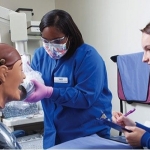5 Unexpected Things You’ll Learn in Culinary School
Many people dream about learning the culinary arts. After watching an entire season of your favorite cooking shows (or even an anime that portrays cooking as a superpower), you might feel inspired to drop everything and enroll in a cooking school.
Upon entering this world, you’ll earn a pedigree to start your own food business. But cooking certification classes can do more than give you the right to own a restaurant or prepare showy dishes. It also teaches you many unexpected things.
While there may be a lot of mistakes along the way, at the end of the day, you’ll be one skill ahead of others who haven’t been in a professional kitchen. But what exactly can you get from partaking in cooking classes?
Below are five things you can look forward to learning when you enroll in culinary school:
1. Perfecting Your Knife Skills
When you enter culinary school, you're not just honing your cooking skills, you'll also sharpen your skills when handling the knife.
For a professional chef, the knife is the most important kitchen tool. This explains why culinary schools – or even amateur cooking classes – emphasize learning the proper way of using a knife.
Since many beginners tend to grip it too far back in the handle, one of the first things you’ll be taught is the correct way to hold a knife. This entails where to grip it and where to place your guide hand. You will also be mastering the “rolling technique” used for cutting herbs and vegetables.
Remember that the trick to cooking all the ingredients evenly is to cut them down to just the right size. Try roasting big chunks of potatoes with minutely minced garlic. You'll find that the latter would burn even before the former is cooked through.
When perfecting your knife skills, you’ll also learn how to cut weirdly shaped onion and oblong carrots in a similar shape and size as a round potato. The key is to practice — a lot.
Once you get used to using your knife, your slices will become nice and even. You’ll even learn fancy knife cuts, such as:
- Julienne
- Chiffonade
- Brunoise
- Roll-cuts
- Batonnet
- Paysanne
- Tournée
2. Sharpening Your Knife
When you practice with your knife a lot, you’ll realize that you can’t be a productive chef without a sharp knife. And in the kitchen, a dull knife is a dangerous knife.
Fortunately, culinary school also teaches aspiring chefs how to sharpen their knives properly.
Keep in mind that, when knives are sharp, it makes chopping and slicing so much easier. Plus, using a sharp knife makes it harder to cut yourself compared to a dull one, which can bounce off and slip from the ingredient you’re prepping and end up somewhere else (like your finger).
Pro Tip: How do you know if your knife is dull? If it bounces off a carrot, it’s dull.
3. Clever Use of Tools
Many tools in the kitchen have more than one purpose. But did you know that, when you learn to become a pro, you’ll also pick up clever and unexpected ways on how to use them?
Below are some examples:
Damp towel
Towels are commonly used for wiping surfaces and even a chef’s sweat caused by the smoldering heat in the kitchen. But there’s one more use for this underrated kitchen tool: to keep the cutting board in place.
Almost any cook – professional or not – would agree that it can be annoying to chop on a cutting board that keeps moving around a slippery counter. To lock it in place, dampen a dish towel and place it underneath the board.
Bench scraper
Like towels, bench scrapers are tools that are made for one purpose but can also be used for another. Besides clearing surfaces, bench scrapers are handy tools that can help you transfer ingredients from a cutting board to a container.
Besides preventing your knife from dulling from dragging across the cutting board, using a bench scraper to move cut ingredients also helps you gather more food at a single time. Thus, less effort is needed.
Ice cream scooper
Ice cream scoopers are good for more than just scooping ice cream – they can also be used to take portions of cookie dough and keep them in the same size when laid out on a baking pan. Cookies that are the same size bake evenly. The same goes for muffins and cupcakes.
4. Mise en Place
Before culinary school, you probably have never heard of the phrase “mise en place.” This phrase, which is French for “everything in its place,” describes when a pro chef prepares everything needed for the recipe before the actual cooking begins.
Culinary students would often begin their cooking sessions with a 15-minute organized scramble that entails grabbing and measuring each and every ingredient they need for the dishes they would cook.
While it may seem like an unnecessary task at first, it can become a habit that will make you more efficient and productive in the kitchen.
Say, for example, you’re making a recipe that requires a lot of mixing, like the risotto. You’ll need salt, pepper, arborio rice, white wine, butter, chopped onions, and grated Parmesan cheese. With mise en place, you’ll never have to leave the pot while the heat is on to prep for the ingredients you need to toss in next.
5. Clean as You Go
If you haven’t developed a habit of cleaning as you go along the kitchen before entering culinary school, you’ll need to learn fast. A professional kitchen should always be tidy, and this is achieved by following a strict protocol of removing trash from your workstation while you work, not after.
Often, pro kitchens have a towel soaked with sanitizer available within an arm’s reach for quick cleanup. They also have a trash bin and a three-compartment sink where you can scrape, wash, rinse, sanitize and air dry items that were used.
Every Move is Important
In the kitchen, every move is important. When you enroll in a cooking class, you’ll learn things you never thought were important but can actually make food preparation much more efficient.
AUTHOR BIO
Shanaaz Raja is the Course Director at International Centre for Culinary Arts - ICCA Dubai.
More to Read:
Previous Posts:

